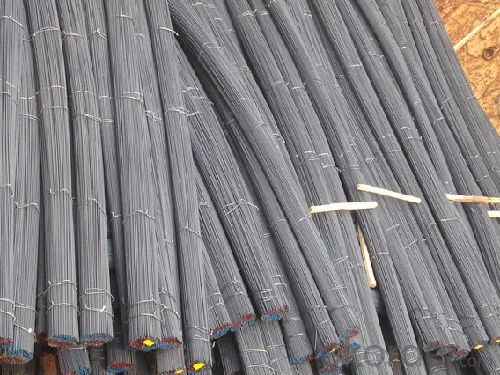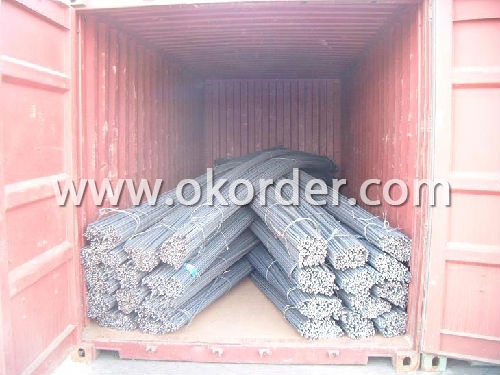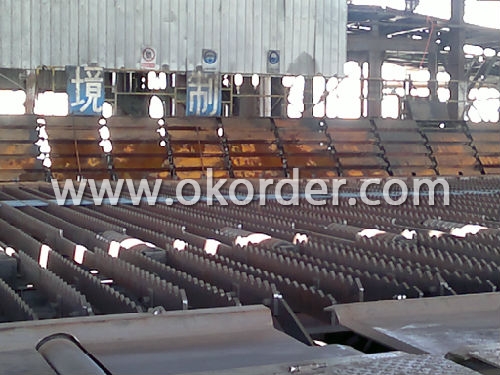High Quality GB Standard Deformed Steel Rebar HRB400
- Loading Port:
- China main port
- Payment Terms:
- TT or LC
- Min Order Qty:
- 50 m.t.
- Supply Capability:
- 100000 m.t./month
OKorder Service Pledge
OKorder Financial Service
You Might Also Like
Specifications of High Quality GB Standard Deformed Steel Rebar HRB400
Standard | GB | HRB400 | |
Diameter | 6mm,8mm,10mm,12mm,14mm,16mm,18mm,20mm, 22mm,25mm,28mm,32mm,36mm,40mm,50mm | ||
Length | 6M, 9M,12M or as required | ||
Place of origin | Hebei, China mainland | ||
Advantages | exact size, regular package, chemical and mechanical properties are stable. | ||
Type | Hot rolled deformed steel bar | ||
Brand name | DRAGON | ||
Chemical Composition of High Quality GB Standard Deformed Steel Rebar HRB400
(Please kindly find our chemistry of our material based on HRB500 as below for your information)
Grade | Technical data of the original chemical composition (%) | ||||||
C | Mn | Si | S | P | V | ||
HRB400 | ≤0.25 | ≤1.60 | ≤0.80 | ≤0.045 | ≤0.045 | 0.04-0.12 | |
Physical capability | |||||||
Yield Strength (N/cm²) | Tensile Strength (N/cm²) | Elongation (%) | |||||
≥400 | ≥570 | ≥14 | |||||
Theoretical weight and section area of each diameter as below for your information:
Diameter(mm) | Section area (mm²) | Mass(kg/m) | Weight of 12m bar(kg) |
6 | 28.27 | 0.222 | 2.664 |
8 | 50.27 | 0.395 | 4.74 |
10 | 78.54 | 0.617 | 7.404 |
12 | 113.1 | 0.888 | 10.656 |
14 | 153.9 | 1.21 | 14.52 |
16 | 201.1 | 1.58 | 18.96 |
18 | 254.5 | 2.00 | 24 |
20 | 314.2 | 2.47 | 29.64 |
22 | 380.1 | 2.98 | 35.76 |
25 | 490.9 | 3.85 | 46.2 |
28 | 615.8 | 4.83 | 57.96 |
32 | 804.2 | 6.31 | 75.72 |
36 | 1018 | 7.99 | 98.88 |
40 | 1257 | 9.87 | 118.44 |
50 | 1964 | 15.42 | 185.04 |
Usage and Applications of High Quality GB Standard Deformed Steel Rebar HRB400
Deformed bar is widely used in buildings, bridges, roads and other engineering construction. Big to highways, railways, bridges, culverts, tunnels, public facilities such as flood control, dam, small to housing construction, beam, column, wall and the foundation of the plate, deformed bar is an integral structure material. With the development of world economy and the vigorous development of infrastructure construction, real estate, the demand for deformed bar will be larger and larger..
Packaging & Delivery of High Quality GB Standard Deformed Steel Rebar HRB400
Packaging Detail: products are packed in bundle and then shipped by container or bulk vessel, deformed bar is usually naked strapping delivery, when storing, please pay attention to moisture proof. The performance of rust will produce adverse effect.
Each bundle weight: 2-3MT, or as required
Payment term: TT or L/C
Delivery Detail: within 45 days after received advanced payment or LC.
Label: to be specified by customer, generally, each bundle has 1-2 labels
Trade terms: FOB, CFR, CIF


Deformed Steel Bar in factory

Note:
1. Our products are produced according to national standard (GB), if not, supply according to national standards (GB) or agreement as customer required.
2. Other Grade and Standard Deformed Steel Bar we can supply:
Grade: GR40/GR60, G460B/B500A/B500B/B500C,BST500S
Standard: ASTM, BS, DIN
The Minimum Order Quantity of these products is high, and need to be confirmed.
3. We can not only supply Deformed Steel Bar; if you need anything about building materials, please contact us for further information.
4. Please send us your detail specifications when inquire. We will reply to you as soon as possible. We sincerely hope we can establish a long stable business relationship.
- Q:Can steel rebars be used in the construction of offshore oil platforms?
- Yes, steel rebars can be used in the construction of offshore oil platforms. Steel rebars provide structural reinforcement and enhance the strength and stability of the platform's concrete foundation. They are commonly used in various offshore structures due to their high tensile strength, durability, and resistance to corrosion in marine environments. Additionally, steel rebars can be designed to meet specific engineering requirements and contribute to the overall safety and longevity of the offshore oil platform.
- Q:Are steel rebars suitable for use in historical restoration projects?
- Yes, steel rebars can be suitable for use in historical restoration projects. They provide structural reinforcement and can help strengthen deteriorated or weakened elements of historical buildings. However, careful consideration should be given to ensure that the use of steel rebars aligns with the original materials and techniques used in the construction of the historical structure. Additionally, the visual impact and authenticity of the restored elements should be taken into account, as steel rebars may not always be ideal for maintaining the historical integrity of the building.
- Q:Can steel rebars be used for both residential and commercial constructions?
- Indeed, steel rebars find utility in both residential and commercial constructions. These sturdy reinforcement materials are frequently employed in concrete structures, imparting them with resilience and steadfastness. Whether it be a residential abode or a commercial edifice, steel rebars are apt for diverse construction ventures. Their utilization guarantees longevity and structural soundness in both domains. Furthermore, steel rebars can be tailored to accommodate specific project prerequisites, rendering them adaptable and fitting for a myriad of applications in residential and commercial construction alike.
- Q:Are steel rebars suitable for use in structures with high wind loads?
- Yes, steel rebars are suitable for use in structures with high wind loads. Steel rebars, also known as reinforcing bars, are commonly used in construction to provide strength and stability to reinforced concrete structures. They are designed to withstand high tensile forces and are an essential component in ensuring the structural integrity of buildings, especially in areas prone to high wind loads. Steel rebars offer several advantages that make them suitable for use in structures with high wind loads. Firstly, steel has high tensile strength, allowing it to resist the forces generated by wind loads. Unlike other materials like timber or concrete, steel rebars have excellent ductility, making them capable of absorbing and redistributing the energy caused by wind-induced vibrations. Secondly, steel rebars are highly durable and resistant to corrosion, which is essential for structures exposed to harsh weather conditions, including high winds. The use of steel rebars prevents the risk of deterioration or weakening of the structure over time due to wind-induced stresses. Thirdly, steel rebars can be easily molded and shaped to fit the specific design requirements of the structure. This flexibility allows engineers to design and construct buildings that can withstand the varying wind loads experienced in different regions. Overall, steel rebars are a suitable choice for structures with high wind loads due to their high tensile strength, durability, and resistance to corrosion. They provide the necessary reinforcement needed to ensure the longevity and safety of the structure in challenging wind conditions.
- Q:What are the guidelines for proper curing of concrete structures with steel rebars?
- The guidelines for proper curing of concrete structures with steel rebars include ensuring that the concrete is adequately hydrated through moist curing methods such as sprinkling water or covering with wet burlap. It is crucial to maintain a consistent and controlled temperature and humidity environment during the curing process to prevent cracking and enhance the strength development of the concrete. Additionally, it is essential to avoid rapid drying and exposure to extreme temperature variations to avoid any potential damage to the steel rebars.
- Q:What are the safety precautions when handling steel rebars?
- When handling steel rebars, there are several safety precautions that should be followed to minimize the risk of accidents or injuries. These precautions include: 1. Personal Protective Equipment (PPE): It is essential to wear the appropriate PPE when handling steel rebars. This includes steel-toe boots, gloves, safety glasses, and a hard hat. PPE will protect against potential hazards such as falling rebars or flying debris. 2. Lifting and Carrying Techniques: Steel rebars can be heavy and difficult to handle. It is important to use proper lifting techniques to avoid strain or injury. Bend at the knees, not the waist, and use the leg muscles to lift the rebar. It is also crucial to avoid overexertion and ask for assistance when handling heavy rebars. 3. Proper Storage: Steel rebars should be stored in a secure and organized manner to prevent them from falling or rolling. Rebars should be stacked flat and not leaning against walls or other structures. Additionally, rebars should be stored away from high traffic areas to avoid accidental collisions. 4. Sharp Edges: Steel rebars have sharp edges that can cause cuts or puncture wounds. It is important to handle rebars with caution and wear gloves to protect the hands. Additionally, rebars should be stored and transported in a way that minimizes the risk of coming into contact with sharp edges. 5. Communication and Warning Signs: When working with steel rebars, it is important to communicate with coworkers and warn them of any potential hazards or activities involving rebars. Clear signage should be posted in work areas to alert others to the presence of rebars and the need for caution. 6. Training and Supervision: Workers should receive proper training on the safe handling and storage of steel rebars. Supervisors should closely monitor work areas to ensure that safety protocols are being followed and provide guidance or corrective action as needed. By following these safety precautions, the risk of accidents or injuries when handling steel rebars can be significantly reduced. It is important to prioritize safety at all times to create a secure working environment.
- Q:What are the safety precautions to be followed while working with steel rebars?
- When working with steel rebars, it is crucial to follow certain safety precautions to prevent accidents and injuries. Here are some precautions to consider: 1. Personal Protective Equipment (PPE): Always wear appropriate PPE, including safety glasses, gloves, hard hats, and steel-toed boots. These items will protect you from potential hazards such as falling objects, sharp edges, and flying debris. 2. Training and Knowledge: Before working with steel rebars, ensure that you have received proper training and understand the safety protocols associated with this task. Familiarize yourself with the equipment being used and understand the potential risks involved. 3. Proper Lifting Techniques: Steel rebars can be heavy and awkward to handle. Always use proper lifting techniques, such as bending your knees and using your legs to lift rather than your back. Never attempt to lift a rebar that is too heavy for you; ask for assistance if needed. 4. Secure Storage: Store steel rebars in a designated area that is clear of any potential obstructions. Stack them in a stable manner to prevent them from toppling over and causing injuries. 5. Safe Handling: When moving steel rebars, be cautious of their sharp edges and potential for injury. Use appropriate lifting equipment, such as cranes or forklifts, if necessary. Avoid dragging or sliding rebars, as this can cause strains or sprains. 6. Fall Protection: If working at heights or near open edges, ensure that proper fall protection measures are in place. This may include using guardrails, safety harnesses, or safety nets to prevent falls. 7. Fire Safety: Steel rebars can become extremely hot when exposed to heat or flame. Ensure that there are proper fire prevention measures in place, such as fire extinguishers, and be cautious when working near flammable materials. 8. Communication: Maintain clear communication with co-workers and supervisors to ensure everyone is aware of their surroundings and potential hazards. Use hand signals or radios when working in noisy environments. 9. Regular Inspections: Regularly inspect steel rebars for any defects, such as cracks or sharp edges, that could pose a safety risk. Remove any damaged or faulty rebars from use immediately. 10. First Aid and Emergency Procedures: Be familiar with first aid procedures and emergency protocols in case of accidents or injuries. Have a well-stocked first aid kit readily available on-site and know the location of the nearest medical facility. By following these safety precautions, you can minimize the risk of accidents and injuries while working with steel rebars. Always prioritize your safety and the safety of those around you.
- Q:What is the difference between steel rebars and FRP rebars?
- Steel rebars and FRP rebars are two different materials used for reinforcement in construction projects. The main difference between steel rebars and FRP (Fiber Reinforced Polymer) rebars lies in their composition and mechanical properties. Steel rebars are made of carbon steel and are known for their high tensile strength and durability. They have been widely used in construction for many years and are a reliable choice for reinforcing concrete structures. On the other hand, FRP rebars are made of fibers, such as glass or carbon, embedded in a polymer matrix. This composite material offers several advantages over steel rebars. Firstly, FRP rebars are lighter in weight, making them easier to handle and transport. This can reduce labor and equipment costs during construction. Secondly, FRP rebars are non-corrosive, unlike steel rebars. Steel rebars are prone to corrosion when exposed to moisture and chemicals, which can weaken the structure over time. FRP rebars do not rust or corrode, making them ideal for environments with high humidity, saltwater, or chemical exposure. Another significant difference is that FRP rebars have a high resistance to electromagnetic fields. This makes them suitable for applications in sensitive areas, such as hospitals, power plants, or telecommunication facilities, where electromagnetic interference should be minimized. However, there are also some limitations to consider with FRP rebars. They have lower tensile strength compared to steel rebars, which means they may not be suitable for heavy-load-bearing structures. Additionally, FRP rebars have a higher initial cost compared to steel rebars, although this can be offset by their long-term durability and reduced maintenance requirements. In summary, the main differences between steel rebars and FRP rebars lie in their composition, mechanical properties, and performance in different environmental conditions. Steel rebars offer high tensile strength but are vulnerable to corrosion, while FRP rebars are lighter, non-corrosive, and have a high resistance to electromagnetic fields. The choice between the two depends on the specific project requirements, load-bearing needs, and environmental factors.
- Q:What are the standard sizes of steel rebars?
- The standard sizes of steel rebars vary, but commonly available sizes range from #3 (3/8 inch diameter) to #11 (1 3/8 inch diameter). Rebars are typically sold in lengths of 20 or 40 feet.
- Q:Are there any limitations on the maximum spacing between steel rebars in concrete?
- Yes, there are limitations on the maximum spacing between steel rebars in concrete. These limitations are specified in building codes and standards. The maximum spacing is determined based on factors such as the structural requirements, load-bearing capacity, and the size and type of rebars used. These limitations ensure the structural integrity and durability of the concrete structure.
1. Manufacturer Overview |
|
|---|---|
| Location | |
| Year Established | |
| Annual Output Value | |
| Main Markets | |
| Company Certifications | |
2. Manufacturer Certificates |
|
|---|---|
| a) Certification Name | |
| Range | |
| Reference | |
| Validity Period | |
3. Manufacturer Capability |
|
|---|---|
| a)Trade Capacity | |
| Nearest Port | |
| Export Percentage | |
| No.of Employees in Trade Department | |
| Language Spoken: | |
| b)Factory Information | |
| Factory Size: | |
| No. of Production Lines | |
| Contract Manufacturing | |
| Product Price Range | |
Send your message to us
High Quality GB Standard Deformed Steel Rebar HRB400
- Loading Port:
- China main port
- Payment Terms:
- TT or LC
- Min Order Qty:
- 50 m.t.
- Supply Capability:
- 100000 m.t./month
OKorder Service Pledge
OKorder Financial Service
Similar products
New products
Hot products
Related keywords




























